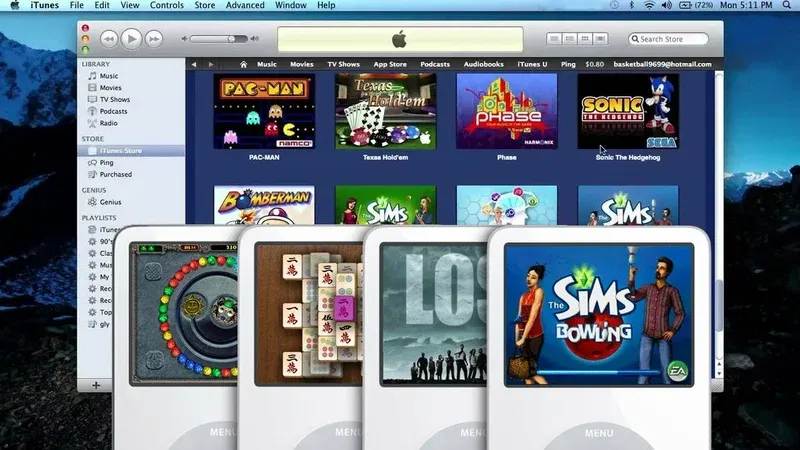The Echo of the Clickwheel: Why iPod News is Surfacing in the Age of Spatial Computing
In a world dominated by the relentless churn of iPhone news and speculative whispers surrounding the Apple Vision Pro news, a faint but distinct sound has re-emerged from the annals of tech history: the satisfying click of an iPod wheel. For years, the iPod has been a relic, a celebrated ancestor in Apple’s family portrait, long since superseded by the all-encompassing power of the iPhone. Yet, recent developments in the retro-tech community have sparked a fascinating wave of iPod revival news. This isn’t just about dusting off old devices to listen to MP3s; it’s a dedicated, highly technical effort to preserve a forgotten corner of Apple’s history—the surprisingly charming world of Clickwheel games. This movement stands as a testament to the enduring power of iconic design and the community’s passion for digital archeology. It forces us to look back at the origins of the mobile revolution and ask what lessons the humble iPod still holds for the sprawling, interconnected Apple ecosystem news of today.
The iPod’s Cultural Impact and the Dawn of Digital Preservation
Before the App Store became a multi-billion dollar behemoth, and long before our wrists buzzed with Apple Watch news, the iPod was the undisputed king of personal technology. Its influence cannot be overstated. It fundamentally changed the music industry and cemented Apple’s reputation for elegant, user-centric design. This legacy, from the earliest iPod Classic news to the final updates on the iPod Nano news and iPod Shuffle news, created a generation of loyal users who remember the device not just as a utility, but as a cultural touchstone.
The Forgotten App Store: An Introduction to Clickwheel Games
While music was its primary function, Apple quietly built a small gaming ecosystem directly into the iPod’s firmware. In 2006, Apple began selling games through the iTunes Store for the 5th generation iPod. These weren’t complex, graphically intensive titles; they were simple, addictive experiences perfectly suited for the Clickwheel interface. Games like Vortex (a Breakout-style game), the classic Klondike solitaire, and Texas Hold ‘Em were designed for quick, casual play. There were 54 official games released in total, each a small, self-contained piece of software. This was, in essence, Apple’s first “App Store”—a curated, controlled digital marketplace that served as a direct precursor to the revolutionary model launched with the iPhone just a year later. This early experiment in mobile gaming is a critical, yet often overlooked, chapter in the history that led to today’s vibrant mobile gaming market.
Why Digital Preservation is Crucial for a Closed Ecosystem
The very thing that makes the Apple ecosystem so seamless—its tightly controlled, proprietary nature—also makes it vulnerable to digital decay. When Apple discontinued the iPod Classic in 2014 and eventually shut down the servers that authenticated and delivered these games, this entire library of software effectively vanished. Without a dedicated community effort, these 54 games would have been lost forever, a footnote in Apple’s history accessible only to those who happened to have them on a functioning device. This is where the recent iPod news becomes so significant. Projects dedicated to archiving and creating methods to reinstall these games are not just acts of nostalgia; they are vital acts of digital preservation. They ensure that a piece of interactive history isn’t erased by corporate product cycles, a concern that remains relevant with every cycle of iOS updates news that leaves older hardware behind.
Unlocking the Vault: The Technical Deep Dive into Resurrecting iPod Games
Preserving and reinstalling iPod Clickwheel games is far more complex than simply dragging and dropping files. It requires a deep understanding of the iPod’s architecture, a willingness to engage with community-developed tools, and a bit of digital bravery. The process highlights the stark contrast between the locked-down hardware of the past and the sophisticated protections discussed in modern iOS security news.

Deconstructing the iPod’s Proprietary Firmware
The core challenge lies within the iPod’s firmware. The games were not standalone applications in the modern sense; they were integrated directly into the device’s operating system. When purchased from iTunes, the game files were encrypted with a key unique to that specific iPod’s serial number. This Digital Rights Management (DRM) was Apple’s way of preventing piracy, but it also created a formidable barrier to preservation. To make these games playable on any compatible iPod, enthusiasts had to reverse-engineer this authentication process. This involved analyzing the firmware to understand how it verified game files and developing patches that could bypass these checks, effectively “jailbreaking” the device for the sole purpose of installing this historical software. This hands-on approach is a world away from the streamlined, secure updates that define today’s Apple privacy news and ecosystem.
The Role of Community and Open-Source Tools
This entire revival is powered by passionate online communities. Using forums and code repositories like GitHub, dedicated individuals have collaborated to create the necessary tools. Projects like the iPod Clickwheel Games Preservation Project have painstakingly gathered all 54 games, stripped their original DRM, and packaged them for public access via torrents and direct downloads on the Internet Archive. Furthermore, they provide detailed instructions and custom software that automates the process of patching the iPod’s firmware and syncing the games. This collaborative, open-source spirit is a fascinating counterpoint to Apple’s top-down corporate structure, which tightly controls everything from HomePod news to the development of Vision Pro accessories.
A Conceptual Guide to Installation
For those curious about the process, here is a high-level overview of how a user can bring these classic games to their old iPod:
- Hardware Acquisition: The first step is securing a compatible device. The most popular models for this hobby are the iPod Classic 5th or 5.5 Generation (“iPod with Video”) and the iPod Nano 2nd or 3rd Generation.
- Software and Game Files: The user must download the preserved game files from a trusted source like the Internet Archive. They also need the specific, community-made utility designed to install them.
- Device Preparation: This often involves restoring the iPod to its factory settings using iTunes or Finder to ensure a clean slate. This is a critical step to avoid software conflicts.
- Firmware Patching: The user runs the custom utility, which identifies the connected iPod and applies a patch to its firmware. This patch modifies the OS to accept the DRM-free game files.
- Syncing the Games: Once patched, the utility allows the user to select which of the 54 games they want to install and syncs them to the device. The games then appear under the “Games” menu on the iPod.
This process is a hands-on technical project, offering a tangible connection to the hardware that is often missing in our modern, cloud-based digital lives.
From Clickwheel to Spatial Computing: The iPod’s Enduring Place in the Apple Ecosystem
The resurgence of interest in the iPod isn’t just a niche hobby; it offers valuable insights into the evolution of the entire Apple ecosystem. It reminds us of the principles that first made Apple a dominant force and provides a grounding context for where the company is headed with its most ambitious products, including the Apple Vision Pro and its future input methods, which might one day be discussed in Apple Pencil Vision Pro news.
A Lesson in Simplicity and Tactile Feedback

The iPod was a masterclass in focus. It did one thing—play music—exceptionally well. Its Clickwheel interface provided a level of tactile feedback that is largely absent from today’s glass-screen devices. In an era of constant notifications and multitasking, the iPod offers a “distraction-free” experience that many now crave. This philosophy of focused, intuitive interaction is something Apple’s designers are surely grappling with as they develop gesture controls for Apple AR and potentially even a Vision Pro wand. The iPod’s success is a powerful reminder that the user experience is not just about cramming in more features, but about making the core function feel perfect. The evolution from a simple click to the haptic feedback in an Apple Watch or the precision of an Apple Pencil on an iPad shows this DNA is still present.
The Blueprint for a Global Ecosystem
The iPod + iTunes model was the blueprint for the modern Apple ecosystem. The seamless synchronization of hardware, software, and a digital storefront created a powerful “walled garden” that was both incredibly user-friendly and incredibly sticky. This model was scaled and perfected with the iPhone and the App Store, and it now extends to every corner of Apple accessories news, from AirPods Pro news to the smart home integration discussed in HomePod mini news. The simple act of buying a game for an iPod was a trial run for the entire digital economy Apple now commands. Even the company’s marketing has evolved from the iconic iPod silhouette ads to the complex narratives seen in Apple TV marketing news, which sell not just a product but an entire lifestyle integrated across devices.
Embracing the Retro Revolution: A Practical Guide and Final Considerations
For those intrigued by this iPod revival news, diving into the world of iPod modding can be a rewarding experience. It’s a journey into the heart of classic Apple hardware and a chance to own a unique piece of technology tailored to your own nostalgic preferences. However, it’s important to approach it with the right mindset and information.
Best Practices and Common Pitfalls

If you’re considering modifying an iPod to play these classic games, keep these tips in mind:
- Choose Your Model Wisely: The 5.5 Generation iPod Classic is often considered the “holy grail” for modders due to its superior audio DAC and compatibility with most mods, including storage upgrades.
- Backup Everything: Before you begin, make a backup of your iPod’s original firmware if possible. While the process is generally safe, having a restore point can prevent a headache.
- Follow Guides Meticulously: The communities that preserve these games also provide incredibly detailed, step-by-step guides. Read them carefully and do not skip steps.
- Beware of Hardware Failure: These are old devices. Hard drives can fail, and batteries have a limited lifespan. Be prepared for the possibility that you may need to replace components. Fortunately, parts like flash-storage adapters and new batteries are readily available.
The most common pitfall is rushing the process and using the wrong software for your specific iPod model and firmware version, which can lead to a “bricked” device. Patience and research are your best tools.
The Future of Retro Apple Tech
The passion for preserving iPod games is part of a larger trend of appreciating and maintaining “obsolete” technology. It provides a tangible hobby in an increasingly virtual world, a stark contrast to creating a digital iPad vision board news-style collage. This movement ensures that future generations can experience the foundational technology that shaped our world. It’s a celebration of repairability, community knowledge, and the timeless appeal of great design, proving that even as we look forward to the latest AirPods Max news or AirTag news, there is immense value in looking back.
Conclusion: The Enduring Beat of an Apple Icon
The renewed interest in iPod Clickwheel games is more than a fleeting trend; it’s a meaningful act of cultural and digital preservation. It demonstrates a deep appreciation for a time when technology was simpler and more focused. This community-led effort has not only saved a library of forgotten software but has also breathed new life into one of Apple’s most iconic products. As the tech world marches relentlessly forward with advancements in AI, health tracking, and augmented reality, as seen in the latest Siri news and Apple health news, the quiet click of a revived iPod serves as a powerful reminder. It tells us that true innovation isn’t just about what’s next, but also about honoring the brilliant designs that brought us here and the passionate communities that refuse to let them fade away.











